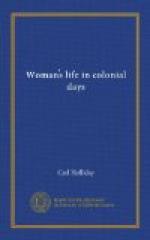Only when the decency and the decorum of the colony was threatened did the stern laws of the church descend upon Mistress Hutchinson and her followers. It was doubtless the riotous conduct of these radicals that caused the resolution to be passed by the assembly in 1637, which stated, according to Winthrop: “That though women might meet (some few together) to pray and edify one another; yet such a set assembly, (as was then in practice at Boston), where sixty or more did meet every week, and one woman (in a prophetical way, by resolving questions of doctrine, and expounding scripture) took upon her the whole exercise, was agreed to be disorderly, and without rule.”
Among the Quakers women’s meetings were common; for equality of the sexes was one of their teachings. In the Journal of George Fox (1672) we come across this statement: “We had a Mens-Meeting and a Womens-Meeting.... On the First of these Days the Men and Women had their Meetings for Business, wherein the Affairs of the Church of God were taken care of.” Moreover, what must have seemed an abomination to the Puritan Fathers, these Quakers allowed their wives and mothers to serve in official capacities in the church, and permitted them to take part in the quarterly business sessions. Thus, John Woolman in his Diary says: “We attended the Quarterly meeting with Ann Gaunt and Mercy Redman.” “After the quarterly meeting of worship ended I felt drawings to go to the Women’s meeting of business which was very full.” What was especially shocking to their Puritan neighbors was the fact that these Quakers allowed their women to go forth as missionary speakers, and, as in the case of Mary Dyer, to invade the sacred precincts of the Massachusetts Bay Colony to proselyte to Quakerism.
VII. Female Rebellion




